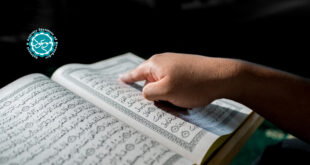Transcript of dialogues between Sunni scholars and Shi’i author, about major topics relating to Shi’ism including the death of the Prophet (s)
, successorship, companions, infallibility, Muta’ (temporary marriage), and the family of the Prophet. Includes a search facility.
Author(s):
● Sultan al-Wa’adhim As-Sayyid Muhammad al-Musawi ash-Shirazi [3]
Translator(s):
● Hamid Quinlan [4]● Charles Ali Campbell [5]
Publisher(s):
● Published 1996 by Pak Books; P.O. Box EE; Palisades; NY 10964 [6]
Category:
● Sunni & Shi’a [7]
Topic Tags:
● Sunni-shia dialogue [8]● Imamate [9]● Wilayah [10]
Important notice:
The Ahlul Bayt DILP team wishes to inform the reader of some important points regarding this digitized text, which represents the English translation of a work originally written in Farsi. Whereas no one can doubt the best intentions of the translator and the publishers in making this title accessible to an English speaking audience, the editing and digitization process of this book (carried out by the DILP Team) has revealed issues in the quality of
translation. Based upon this fact, the DILP team has taken the liberty to make grammatical corrections to make the text more readable and less ambiguous; spelling mistakes and typographical errors have also been corrected and an attempt has been made to improve the highly non-standard use of transliteration of Arabic names and terms. The online text is not an exact reproduction of the original translation. Users wishing to see the translation as it was published should refer to printed copies available in bookshops. Those who understand are advised to refer directly to the original text. The Ahlul Bayt DILP Team
Translators’ Preface
Recently the non-Muslim world has forcibly learned that Islam is divided into two sects, Shi’as and Sunni, but there is so little material in languages other than Arabic and Persian on the Shi’as side of the issue that real understanding is all but impossible. This is the consequence of the historical accident that Western contact with Islam was almost entirely with Sunni communities, Saudi Arabia, Egypt, Ottoman Turkey, most of Muslim India, etc.
The present work corrects this imbalance in a most extraordinary way, for the case for Shi’ite Islam is argued and supported virtually entirely from orthodox Sunni sources. The political, juridical, and spiritual legitimacy of the Shi’ite position has been argued, and documented in the English language, and from sources that the West has largely overlooked.
In fact, it is shown here that the most authoritative source for interpreting of the message of the Prophet Muhammad was his cousin and son-in-law, ‘Ali Ibn Abi Talib, and the eleven other designated successors after him, who constitute the Imams of the Ithna Asheri (Twelve Imam) Shi’as. At various times in history this fact has been more, or, less recognized by the Muslim world.
As recently as 1959, for example, Sheikh Mahmud Shaltut, late Rector of Al-Azhar University in Cairo, and the Grand Mufti of the Sunni Sect, decreed that in addition to the four Sunni schools of Muslim canon law, Hanafite, Hanbalite, Malakite, and Shafi’ite, the Ja’farite or Shi’as school of law was equally acceptable to Muslims.
A brief account of how this came about at the instigation of Imam Mohamad Chirri, Director of the Islamic Center of North American in Detroit, Michigan, may be found in Chirri’s book “The Shiites Under Attack,” published by the Center.
* * *
The present work is based on the transcript of a dialogue between several Sunni divines
and a 31 year-old Shi’ite scholar, al-`Abd al-Fani Muhammad al-Musawi Sultanu’l-Wa’adhim, of Shiraz, Iran, held over a period of ten nights in Peshawar, India, beginning on 27 January
1927. The dialogues were a model of mutual respect, and in spite of the seriousness of the subject and the presence of an audience of some 200, there was no breach of decorum.
The author refers to himself throughout the book as “Da’i,” that is, one who prays for or invokes a blessing upon someone, translated here as “Well-Wisher.” His success is indicated by the fact that at the end of the dialogue one of his Sunni opponents and five other dignitaries in the audience publicly acknowledged their conversion to the Shi’as sect.
A condition of the dialogue was that only sources acceptable to both sects would be cited. The dialogue was held in Farsi, commonly understood in the city of Peshawar. The transcript, made by four reporters and published in the newspapers daily, was published in book form in Teheran and soon became a classic authority in the East. The present work is based on the fourth edition, published in Teheran in 1971, the year in which Sultanu’l- Wa’adhim died at the age of 75.1
Although the dialogue was extemporaneous, such was the erudition of Sultanu’l-Wa’adhim Shirazi (whose name means “Prince of Preachers from Shiraz”) that the transcript serves as a detailed bibliographic reference to hundreds of Sunni treatises, well known and little known, in which the claims of the Shi’ites are acknowledged. For this reason, many of the citations refer to the author’s recognized sect or school, i.e., “Sulayman Balkhi Hanafi,” indicating an adherent to the Hanafite Sect, Sibt Ibn Jawzi Shafi’i, of the Shafi’ite sect, and so on.
In spite of the acceptance of the thesis of this book in many parts of the Sunni world, it has also aroused hostility, and unfortunately has inspired misguided and even perverse meddling with the published authorities. In his introduction to the fourth Persian edition, the author writes:
“…it is unfortunate enough that the selfishness of some of the scholars reached the point that their commitment to their own belief overcame them, and they dared to meddle with the great works, supposing that by changing or effacing certain studies the truth would be brought out!”
And since the state of him to whom God Most High has entrusted the security and preservation of the truth (namely al-Wa’adhim, who was near the end of his life at the time of writing tr.) does not allow much time for writing an explanatory introduction to this treatise, confirmation of this mischief will be indicated by one example below.
On page 301 of the third volume of the Commentary, Kashshaf, compiled under the direction of Sheikh Mustafa al-Halabi (2nd edition, 1319 A.H. published by the Main Government Printing House of Amiriah Bulaq of Egypt), verses appear in which Jarullah Zamakhshari, the commentator of the Kashshaf, declared publicly his belief in the legitimacy of the Shi’ites. But in the edition of 1373 A.H. from the printing house Istiqamah bi’l-Qahara the aforementioned poem is not to be found.
This is a sample of the actions of the gentlemen of the Sunnis. By the same token some references which we have indicated in the text of this compendium (i.e., the present book – tr.) are not to be found in the newer editions of those references. This is further indication of what has been said. For this reason some of them have been quoted extensively so that you may read them in this summary.”
We have heard that this kind of mischief is continuing today, with new, well-financed expurgated editions of the basic collections of traditions, i.e., Bukhari, Muslim, Tirmidhi, etc., being offered unsuspecting libraries, to replace the older, but complete editions!
It is for this reason that the extensive bibliographic references in the original have been retained here at the price of making the book lengthier and less easy to read.2
Thus, the work will find a place in every Department of Near Eastern Studies and every divinity school concerned with ecumenical problems in the modern world. It should be
closely studied by serious students of political science and world history who are attempting to understand the emerging presence of Islam in world affairs.
And it should, of course, be of intense interest to all English-speaking Muslims who wish to have confidence in the sources on which they depend for their understanding of Islam.
* * *
Among the topics treated in detail are the events surrounding the death of the Holy Prophet, his attempt to make a written will, which was frustrated by Omar, and the secret election of Abu Bakr, the first two successors or ‘caliphs’ of the Sunni Muslims. Also treated in detail are the events at Ghadir Khum at which ‘Ali is believed by the Shi’as to have been explicitly designated by the Prophet as his successor. These are matters of incalculable significance to subsequent history and to the alignment of forces today.
Other topics concern misinterpretation of quotations from the Prophet used to argue that any one of his companions was infallible, thus legitimizing the appalling oppression of the people by many subsequent generations of ‘successors,’ misinterpretation of the presence of Abu Bakr in the Cave with the Prophet during his flight from Mecca to indicate a singular honor; Abu Bakr’s unjust seizure of the property of the daughter of the Prophet; the errors and weaknesses of the Caliph Omar, who acknowledged his dependence upon ‘Ali to interpret Islamic law (Shari’at), and his termination of the practice of Muta’ (temporary marriage) contrary to the decree of the Prophet, as supported by correct understanding of the Qur’an.
The cruelty the Caliph Uthman showed to distinguished Companions who supported ‘Ali, such as Abu Dharr; and the strange position of the Prophet’s young wife, A’ysha, daughter of Abu Bakr, who led a military campaign against ‘Ali, husband of her contemporary, Fatima, the Prophet’s own daughter of whom she was fiercely jealous.
Fundamental to all of these is the question of the authority for transmission, and interpretation of Islamic law and science. This was codified among the Sunnis by four principle legalists in the second and third centuries A.H.
Their opinions contradicted each other incredibly on such issues as the lawfulness of wine and eating dog’s flesh, and permissibility of marriage to one’s own daughter. By contrast, the Shi’as transmission has been singular and consistent – And in reality was often quoted by Sunni authorities in the past, a fact until now ignored, forgotten, or suppressed.
* * *
A word needs to be added regarding the transliteration of Arabic and Persian words. We have attempted to follow a middle course between rigorous replication of the full range of the Arabic and Persian sounds, and avoiding any forms that would be daunting to the non- Arabist. We have tended toward the latter, reasoning that the Arabist will recognize and resolve any ambiguities in the treatment, while the non-Arabist needs forms that are recognizable and pronounceable.
Therefore we have not attempted to differentiate between aleph (long ‘a’) and fatiha (short
‘a’), using ‘a’ in all cases. Similarly we have shown yah (long ‘i’) and kasra (short ‘i’) as ‘i’ except for a few cases where the words are commonly known one way, or, the other, i.e.,
‘Sulayman.’
Nor have we attempted to distinguish the two letters, ‘sin’ and ‘sad.’ Both are rendered as
‘s.’ ‘Tha,’ another letter often transliterated as ‘s,’ we have shown as ‘th’ in, for example,
‘Ibn Thabit.’ Similarly ‘zay’ and ‘zah’ are both shown as ‘z.’ The ‘dhad,’ rendered by some as
‘z’ we have distinguished by using ‘dh’ as in ‘dhikr’ or ‘Ramadhan,’ instead of ‘z.’
The Arabic and Persian ‘qaf’ is given as ‘q’ to distinguish it from the ‘ghayn’ which is given as ‘gh.’ There is no true ‘g’ sound in Arabic, but when it appears in Persian words it is transliterated as ‘g,’ while the ‘jim’ which in Cairo is transliterated as ‘g’ and by the Encyclopedia of Islam as ‘dj’ is here simply ‘j.’
The subtleties of the Arabic terminal ‘ah’, which in some contexts is pronounced like English
‘ah’ and in others like ‘at’ have been largely effaced, the rendering being usually simply ‘a’. In combination and in certain plurals, however, ‘at’ is retained.
The Persian ‘ezafeh’, which is used to indicate possession by linking the possessor and the possessed (the Persians would say Ibn al-Malik to indicated the son of the king, whereas the Arabs would say Ibni’l-Malik) is difficult to handle. It is usually not written, but understood, and it is not readily apparent in titles of works whether they are in fact Persian or Arabic.
For example, ‘Kifayatu’t-Talib fi Manaqib al-’Ali Ibn Abi Talib’ appears to refer to a work in Arabic ‘Kifayatu’t-Talib’ (Intensive Studies) on the subject of the ‘Manaqib al-’Ali’, i.e., the virtues of ‘Ali. This ‘ezafeh’ is variously given as ‘i’ or ‘e’, coupling either words with hyphens or merely joined to the first with or without a hyphen.
Thus you will see ‘Ahlul Bayt’ (the people of the house, referring specifically to the immediate family of the Prophet through his daughter, Fatima, and her husband, ‘Ali), and
‘Sharh al-Nahju’l-Balagha,’ ‘Explanation of the Eloquent Sermons’ (by Ibn Abi’l-Hadid)
regarding the addresses of ‘Ali Ibn Abi Talib.
* * *
Many of the sources quoted are obscure, not available in English, and often referred to in various ways by scholars, and sometimes even by the author, Sultanu’l-Wa’adhim. Where possible, these problems have been resolved, and the name of the work or author commonly used by scholars is given.
Although we have worked from the Persian edition, we would like to acknowledge the help of an English translation published in 1977 by the Peermahomed Ebrahim Trust in Karachi. A similar debate, but by exchange of letters, was published in 1936 and reissued under the title of ‘The Right Path’ (originally ‘al-Muraja’at) by Peermahomed Ebrahim Trust in 1972.
A revised edition was issued by Zahra Publications, Blanco, TX in 1986. This exchange began in 1911 between the Sunni head of Al-Azhar University in Cairo and an eminent Shi’as scholar from Lebanon, explaining the Shi’as beliefs. Its publication no doubt laid the groundwork for the eventual formal recognition by Al-Azhar University in 1959 of the Shi’as Ja’farite school of jurisprudence, identified with the Shi’ite Imam Ja’far Sadiq, mentioned above.
May Allah forgive our errors, and accept our intention, and bless Muhammad and his family! Hamid Quinlan
Charles ‘Ali Campbell
11 Jamadi al-Awwal 1416 A.H.
7 October 1995
1. The death of Sultanu’l-Wa’adhim in 1971 is mentioned by Michael M.J. Fischer in Iran – From Religious Dispute to Revolution – p.178, Harvard University Press 1980.
2. For instance, see Tahrif! Investigating Distortions in Islamic Texts for a few documented examples of such changes in Sahih al-Bukhari, Sahih al-Tirmidhi, and other books [Ed.]
First Night Second Night Third Night Fourth Night Fifth Night Sixth Nigh Seventh Night
 Mouood Mouood English Edition
Mouood Mouood English Edition




